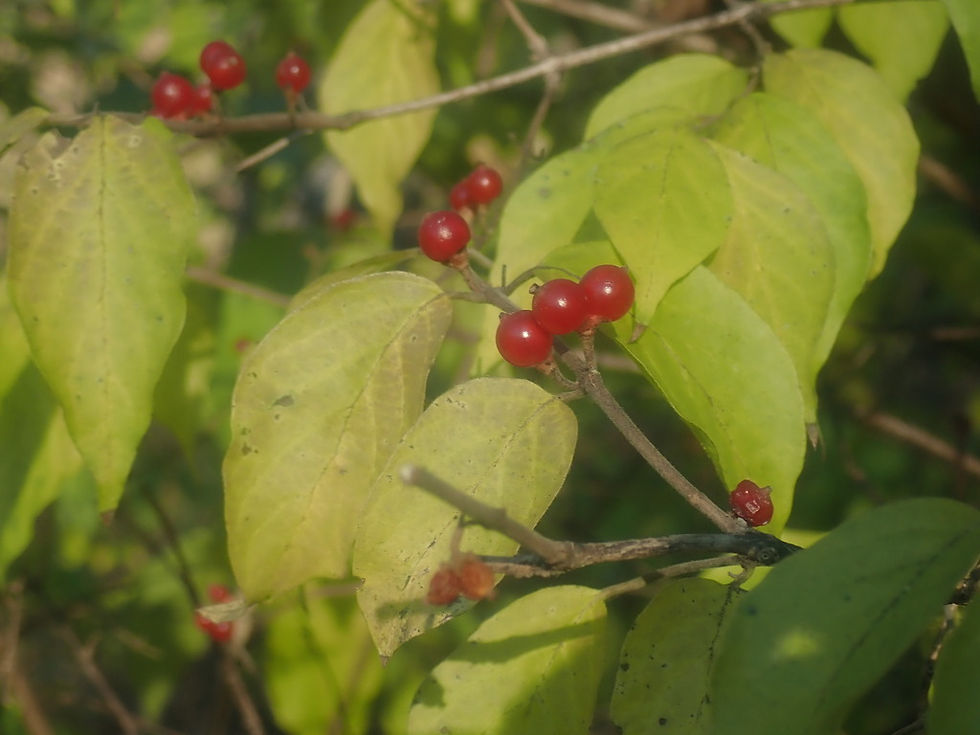Amur Honeysuckle Invasive Removal
- gracemccutchen
- Dec 24, 2023
- 3 min read
Updated: Jan 29, 2024
Did you know that the leafy shrubs you see this time of year are likely the non-native Amur honeysuckle (Lonicera maackii)? This invasive shrub was introduced into the US in the late 1800’s as an ornamental shrub, and was even promoted by botanical gardens and wildlife agencies for erosion control and wildlife food.
In the past few decades, it has become one of the most dominant (if not THE most dominant) species in urban and wild areas in central Ohio. This is a HUGE problem for many reasons.

Amur honeysuckle is the first species to leaf out in spring, and the last to lose its leaves in fall, which deprives the plants below it from photosynthesizing. As if that weren’t enough, it’s also allelopathic, meaning that it secretes harmful compounds from its root system that deter the growth of nearby plants. It’s even been shown to be harmful to amphibians and insects (except ticks, mites and mosquitoes, which it’s now known to benefit!).
Like other invasive, non-native species, Amur honeysuckle has ecological controls in its home habitat that it lacks here. And though the berries lack the fat, protein and nutrition provided by the berries of native shrubs such as dogwood, spicebush and viburnum, birds eat them in the absence of other options, then eliminate them, often at great distances from the parent plant. This helps the plant spread, further increasing bird consumption.
Our bird populations have enough challenges without junk food berries replacing their more desirable and nutritious fare!
AND the berries aren’t just harmful to birds - they’re also toxic to people and pets.
Identification

Look for dense shrubs with long, arching branches and 2-3 inch (still present in late fall/early winter!) leaves that are sharply pointed and opposite along the stem. Most shrubs will have numerous red berries late in the season, arranged in clusters along the branches.
Removal
Fortunately, Amur honeysuckle has a very shallow root system, so small plants can typically be pulled by hand when the soil is moist, as it typically is in late fall.
For larger shrubs or heavy infestations, most habitat managers use a “hack and squirt” method. As a naturopath (Patty speaking here), I’m pretty anti-chemical in general but have found that there are some invasive plants that it’s nearly impossible to eliminate any other way…and stump-treating uses far less herbicide than a foliar spray approach, without the danger of killing nearby desirable plants.
Once an area is cleared, it will require maintenance, but Amur honeysuckle doesn’t fruit until it’s 3-4 years of age, and the small shrubs are easy to spot in late fall, and easy to pull. It's a regular part of a walk around the property here at the nursery these days.
Helping in the Community
If you’re one of the few lucky folks who isn’t battling Amur honeysuckle, consider doing what Marty Freado of Westerville did.
Upon learning of the destructive nature of Amur honeysuckle, Marty realized Metzger Park, the park she frequents, was being choked out by this noxious shrub. She approached the park manager and offered to organize a volunteer effort to remove the honeysuckle. The offer of help was gratefully accepted, and Marty began gathering volunteers for two hours on Saturday mornings in spring and fall.
Since early 2021 when the work began, her volunteer initiative has removed around 20,000 of these invasive shrubs, allowing the return of spring ephemerals that now blanket the cleared areas of the park!
If you'd like to connect with an existing volunteer effort near you, check out our community resource page. If you manage a park or similar wild area in Ohio with public access, provide us your contact information so we can help you connect with community heroes near you.





11111
111
I love how this article addresses the importance of removing invasive plants like Amur honeysuckle. It’s such a crucial step in protecting local ecosystems. Proper management of invasive species not only ensures the health of our environment but also helps maintain biodiversity. I’ve been exploring various strategies for promoting environmental awareness, and I found that using outreach seo techniques can be incredibly effective in spreading vital information. By reaching a larger audience through the right SEO methods, we can share important topics like invasive species management with more people, encouraging them to take action.
Want to stop watching charts 12 hours a day? Automate your trading logic on https://cryptorobotics.ai/ and focus on what actually matters.
Nice article! Just dropping a few more links that may interest others:
https://dolacesolutions.com/2025/07/14/understanding-the-basics-of-online-casinos/
https://indiatourorganizers.com/unveiling-the-secrets-behind-casino-slot-machine/
http://blueberryhome.in/2025/07/14/unlocking-the-future-of-online-casinos-trends-and/
http://www.fording.ca/unlocking-the-secrets-of-casino-game-algorithms/
https://hamrhrconsultant.online/winning-strategies-mastering-the-art-of-online-2/
https://hustlersolutions.com/2025/07/13/jackpot-dreams-unveiling-the-secrets-of-winning/
https://futuresoulmatedrawing.com/2025/07/13/unveiling-the-secrets-behind-casino-loyalty-2/
https://forex.akko.pro/2025/07/13/unveiling-the-secrets-behind-casino-loyalty/
https://finewoodflooringllc.com/mastering-the-art-of-bluffing-strategies-for-2/
https://friendsitsolutions.in/2025/07/13/unveiling-the-future-of-online-casinos-trends-to-4/
https://eblapp.com/2025/07/13/unveiling-the-future-of-online-casinos-trends-to-2/
https://designmyslides.com/unveiling-the-future-of-online-casinos-trends-and/
https://coachblac.com/unraveling-the-future-of-cryptocurrency-in-online/
https://biotecuae.com/mastering-the-art-of-bluffing-winning-strategies/
https://bestieclothes.com/2025/07/13/unraveling-the-mysteries-of-slot-machine/
https://awgro.in/unraveling-the-future-of-cryptocurrency-in-online/
https://adwinupvc.ae/2025/07/13/unlocking-the-secrets-of-successful-sports-betting/
http://www.poyraztarimurunleri.com/2025/07/13/unveiling-the-secrets-behind-casino-loyalty-2/
http://www.opulentdecor.in/2025/07/13/unveiling-the-future-of-online-casinos-trends-to/
http://www.galcorp.com.ph/2025/07/unlocking-the-secrets-of-successful-online-casino/
http://www.decolux-kw.com/exploring-the-rise-of-live-casino-gaming-in-the/
http://www.capacitybuildingconcierge.com.au/unlocking-the-secrets-of-successful-online-casino/
http://silvermountainpartners.com/winning-streaks-the-science-behind-casino-luck/
http://furnitureplus.com.pk/unlocking-the-future-how-ai-is-revolutionizing/
http://jsjazzyboutique.com/2025/07/13/winning-strategies-elevate-your-game-with-expert/
http://bigbootyheaven.com/2025/07/13/mastering-the-art-of-bluffing-winning-strategies/
https://www.sofa-lab.com/unlocking-the-secrets-of-online-casino-bonuses-2/
https://www.surface-systems.com/2025/07/14/unlocking-the-secrets-of-online-casino-bonuses/
https://suzukichampionmotors.com/unlocking-the-future-of-online-gambling-trends-to/
http://www.dacen.co.za/winning-strategies-mastering-the-art-of-online/